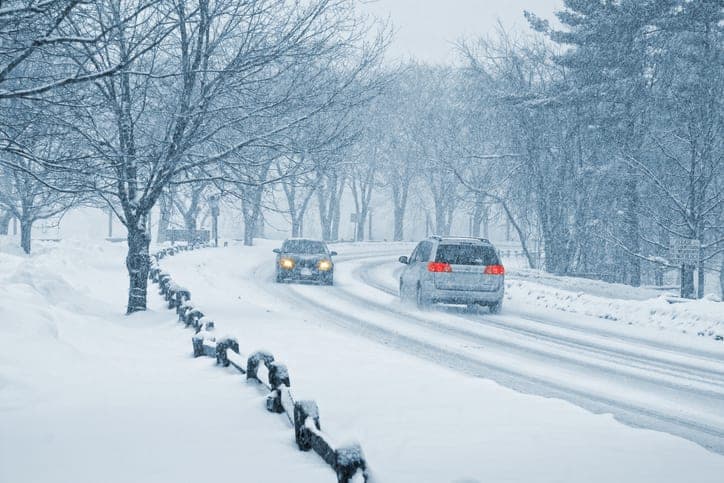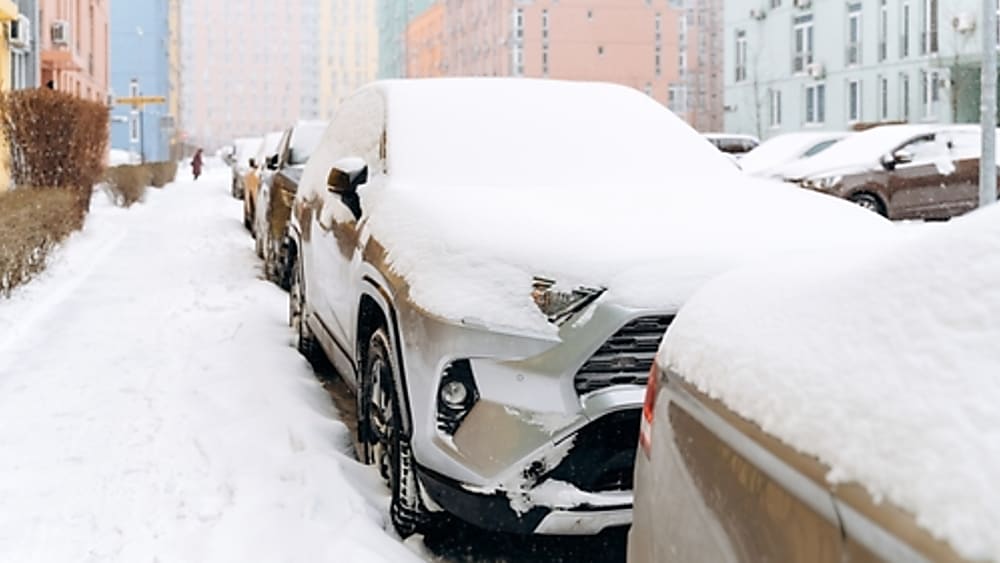Tire maintenance & safety
Winter driving tips to stay safe in inclement weather

Free shipping
Best price guarantee
Special pricing
Financing with Resolve
Easy returns
Tire maintenance & safety

Winter weather transforms familiar roads into treacherous paths where snow, ice, and sleet create hazardous conditions that challenge even experienced drivers. Each year, winter storms contribute to nearly half a million crashes and more than 2,000 road deaths, making preparation and proper driving techniques essential for safe travel.
The combination of reduced visibility, slippery surfaces, and unpredictable weather patterns demands a different approach to driving than what works during warmer months. Cold temperatures affect everything from tire pressure to battery performance, while snow and ice dramatically reduce traction and increase stopping distances.
Understanding how to prepare your vehicle and adapt your driving style for winter conditions can mean the difference between arriving safely at your destination and becoming another accident statistic. The following comprehensive guide provides practical strategies and essential knowledge to help you navigate winter roads with confidence.
Winter driving presents unique challenges that extend far beyond simply dealing with cold temperatures. Snow-covered roads can hide dangerous ice patches, while reduced daylight hours combine with precipitation to create visibility problems that make it difficult to spot hazards, other vehicles, or even the road itself. The National Highway Traffic Safety Administration reports that 17% of all vehicle crashes occur during winter weather conditions, with 1,836 deaths and 136,309 injuries occurring annually due to crashes on snowy, slushy, or icy pavement.
The physics of winter driving work against you in multiple ways. When temperatures drop below freezing, your vehicle's tires lose flexibility and grip, while snow and ice reduce the coefficient of friction between your tires and the road surface. This means that actions you take for granted—accelerating, turning, and especially braking—require significantly more time and distance to execute safely. A car traveling at just 30 mph on dry pavement needs about 75 feet to stop, but on packed snow, that distance increases to 150 feet, and on ice, it can exceed 300 feet.
Beyond the immediate dangers of losing control on slippery surfaces, winter weather creates additional risks that compound the hazards:
Understanding these risks helps explain why winter driving demands both thorough preparation and a fundamental shift in driving behavior. The margin for error shrinks dramatically when road conditions deteriorate, making it essential to approach winter driving with respect for the conditions and a commitment to safety-first decision making.
Preparation and knowledge are your best allies when facing winter's challenges on the road. Ensure your vehicle can withstand cold and slippery conditions by checking your tire tread and air pressure, as colder temperatures often lead to reduced tire pressure. Opt for winter or all-season tires for enhanced traction on icy roads. Keep the fuel tank at least half full to prevent the fuel line from freezing and ensure you have enough fuel for any unforeseen delays.
No driver should venture out in winter without a well-stocked emergency kit. Include a snow shovel for removing snow from around your tires, a warm blanket for keeping cozy during unexpected stops, and a flashlight to improve visibility in low-light conditions. Pack non-perishable snacks and bottled water to help sustain you if you become stranded, and a first-aid kit to address minor injuries on the spot. A phone charger is essential for maintaining communication, crucial for both navigation and emergency assistance.
Adjusting driving techniques to the winter environment is crucial. Drive at a reduced speed and increase the distance between your vehicle and others to allow more time for stopping. Avoid sudden maneuvers that could lead to skidding; instead, apply gentle pressure when accelerating and braking. Understanding how to handle skids is vital: steer in the direction you want to go, and refrain from slamming the brakes. Regaining control gradually is key to preventing accidents on icy roads.

Getting your vehicle ready for winter involves a thorough check-up to ensure peak performance in cold weather conditions. Begin with an evaluation of your tires, as they are essential for maintaining contact with the road. Inspect each tire for sufficient tread depth—winter tires are particularly effective, thanks to their specialized tread designs and rubber compounds that stay flexible in cold temperatures. This flexibility enhances traction, making them a superior choice for navigating snow and ice compared to standard tires.
The vehicle's electrical system, especially the battery, requires careful attention during winter. Cold temperatures can diminish a battery's efficiency, so it's crucial to ensure it is fully charged and that the connections are clean and secure. Regularly inspect the battery terminals for any signs of corrosion. Consider switching to winter-grade windshield wiper blades designed to handle snow and ice more effectively. Fill the windshield washer reservoir with a fluid that is specially formulated to resist freezing, which is indispensable for maintaining visibility during snowstorms.
Focus on the overall mechanical readiness of your vehicle. Verify that the antifreeze level is adequate and the mixture is optimal to prevent the engine from freezing. Check the braking system to confirm it is in top condition, as stopping distances can increase on icy roads. Ensure your heating system is working properly, as a good defroster not only keeps the cabin warm but also clears the windows for safe driving. These steps are vital to ensure your vehicle remains reliable and safe throughout the winter months.
Equipping your vehicle with a comprehensive emergency kit is a proactive measure that can make a significant difference during winter travel. This kit acts as a lifeline in situations where you might be delayed or stranded, providing both comfort and essential supplies. Start with a collapsible snow tool—compact for storage but effective in freeing your vehicle. Pair it with traction aids like sand or kitty litter to help free your vehicle from icy patches.
A well-prepared kit should also include items that ensure warmth and visibility. Pack a thermal blanket or insulated covering to retain body heat if you need to wait for assistance. Include a lantern or headlamp with extra batteries to maintain visibility during nighttime or low-light conditions. Reflective triangles or emergency beacons can alert other drivers to your presence, enhancing your safety on dimly lit roads.
In addition to basic survival items, think about sustenance and communication. Energy bars and sealed water pouches help maintain energy levels during extended waits. A compact first-aid pouch is essential for addressing minor injuries until professional help arrives. Don't forget a power bank to keep your mobile device charged, allowing you to communicate or access crucial information. These thoughtful inclusions ensure preparedness for a range of winter driving scenarios, turning potential emergencies into manageable situations.
Winter driving demands a strategic approach that prioritizes safety and control, adapting to the unpredictable nature of icy and snowy roads. Begin by establishing a greater buffer between your vehicle and others, ideally maintaining a distance that provides ample room for unexpected stops. This extended space acts as a safety cushion, allowing for smoother transitions and reducing the risk of collisions in adverse conditions.
Emphasize smooth transitions in your driving style. Rather than abrupt acceleration, gently ease into your speed to maintain steady traction and prevent the tires from losing grip. When slowing down, apply the brakes gradually, allowing the vehicle's momentum to decrease naturally. Vehicles with anti-lock braking systems (ABS) benefit from consistent brake pressure, helping to avoid wheel lock-up and maintain steering control.
Mastering the art of steering requires anticipation and a delicate touch. Approach turns with reduced speed, and use gentle steering inputs to navigate curves without causing a loss of control. In the event of a skid, focus on steering smoothly towards your intended path. This approach helps regain traction without exacerbating the slide, ensuring a more controlled response to winter's challenges.
Encountering a skid on an icy road can be unsettling, yet staying composed is crucial for regaining control. Skids occur when the tires lose traction with the road due to sudden movements. Grasping the dynamics of skids equips you to respond promptly and effectively, reducing the risk of an incident.
When your vehicle begins to skid, focus on aligning the car with your intended path. Steering gently towards where you want to go helps the tires regain their grip, assisting in realigning the vehicle. For rear-wheel-drive cars, maintaining balanced throttle control can prevent additional rear-end swing.
Braking requires a careful approach; avoid abrupt pressure, which can worsen the skid. For vehicles without anti-lock brakes, gradually apply and release the brake to help regain traction. If equipped with ABS, maintain firm pressure on the brake pedal as the system works to prevent wheel lock-up. This enables the tires to reestablish contact with the road, stabilizing the vehicle and diminishing the skid's severity.
Keeping calm remains vital. Overreaction can turn a minor skid into a complete loss of control. Grip the steering wheel lightly, using smooth, controlled movements. Stay aware of the road ahead, adjusting your actions according to the vehicle's response. Knowledge and confidence are your best assets for navigating skids safely, turning a potentially dangerous situation into a manageable one.
Navigating through winter's challenges necessitates a thorough understanding of your vehicle's capabilities and the environmental conditions. Monitoring weather patterns and road updates gives you the foresight needed to prepare adequately for trips. This vigilance allows you to anticipate obstacles and equips your vehicle to handle various winter scenarios effectively.
Beyond just mechanical readiness, embracing the subtleties of winter driving enhances your assurance on the road. Acquaint yourself with your vehicle's safety features, such as electronic stability control, which can aid in maintaining control on slippery surfaces. Employing strategic driving practices—like anticipating potential hazards and maintaining a safe distance from other vehicles—strengthens your ability to respond swiftly and accurately.
Winter driving is as much about mental preparedness as it is about physical readiness. Cultivating a cautious and patient approach ensures that every decision prioritizes safety. By leveraging the right information, utilizing the appropriate tools, and fostering a responsible driving attitude, you transform challenging winter journeys into confident and secure travels.
Winter driving safety starts with proper preparation and the right equipment, especially when it comes to your tires—the only point of contact between your vehicle and those icy roads. Quality winter tires can dramatically improve your vehicle's traction, handling, and stopping power when you need it most. Ready to upgrade your winter driving safety? Shop for tires online and find the best deals to ensure you're equipped with the right tires for whatever winter throws your way.
Search By